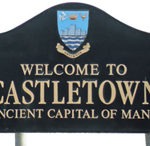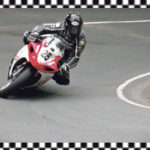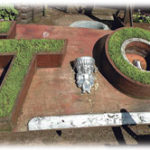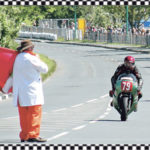Manx mad for motorcycling
A Harley-riding Yankee visits the Isle of Man
Douglas, Isle of Man, May 30–June 13—Billed with slogans like “Sheer Nerve” and “Pure Courage,” and touted as the greatest road race in the world, the Isle of Man TT is an event that should be way up there on any motorcycle enthusiast’s “must experience” list. (I hesitate to use the currently popular term “bucket list,” because that would imply that you could go ahead and die after you complete the list.) You might think a visit to this sovereign island nation, the world’s oldest democracy, located in the middle of the Irish Sea, would be a once-in-a-lifetime experience, but once you’ve been immersed in the spectacle and completely embraced by the inhabitants, your next list will itemize everything you want to do on your next trip back to the TT.
The 2009 event marked 102 years of exceptional racing on a time-trial basis over public roads closed for racing by proclamation of the Isle of Man government. Yes, you heard right. The whole island gets behind the racing, whether or not they ride themselves, and youngsters and grandparents and all ages in between can be seen lining the city streets and country roads over this approximately 37-mile course, awaiting the powerful bikes with the daring riders rocketing past at speeds up to 200 mph. George, a neighbor of mine in California, grew up on the Isle of Man and was very excited when I told him of my trip. Even though he never rode a bike himself, he is a tremendous motorcycle racing fan and can quote the winners of races from year to year. It is a real passion for the Manx people.
The location of the isle makes for some interesting logistics for competitors and spectators alike, as it’s a 70-mile ferry boat ride from Liverpool across the Irish Sea to Douglas. If you’re not bringing a motorcycle, an hour flight out of London to the airport in Castletown and a bus ride to Douglas makes for a more pleasant introduction to the culture. It would be possible to rent a vehicle to get around the island nation, but from an American tourist’s perspective, mass transit and good old shank’s mare will suffice for the first trip, at least.
Douglas is a good base of operations for enjoying all that the event has to offer. Upon debarking the bus at the Promenade, a sweeping stretch of road and walkway above the seafront, you can see the festival tents being prepared for the fortnight of total motorcycle culture. The walk from the bus is not unpleasant with the beautiful bay for a view, and the other side of the street lined with hotels, apartments, restaurants and retail establishments. The locals turn out in force to enjoy the late sunlight on a June evening in this very northern location. A few bikes cruise by, and cruise by again. It’s a small island.
Douglas is the location of the start/finish of the race and is home to an impressive permanent race headquarters and grandstand with limited area for competitors’ pits and vendors. Adjacent vacant lots provide spillover pit areas. The huge two-tiered scoreboard set up on the opposite side of the road from the grandstand is operated by local Boy Scouts with a manual system—no electronics involved. It keeps the boys occupied and off the streets, and the scoreboard actually hides the view of the cemetery located across from the grandstand.
The 37.73 mile TT Mountain Circuit, so called because it rises at one point to the highest point on the isle, 1,400 feet, travels through very rural and agricultural country as well as through the island’s four main population areas, beginning in Douglas, heading west to Peel, north to Kirk Michael, east to Ramsey, and back south to Douglas again. Along the way there are 39 well-documented “best viewing spots” with their own unique names; some in the Celtic language, as most signage on the isle is offered in both English and Celtic. Veteran spectators will eagerly offer their suggestions: Bradden Bridge, Elm Bank, Ballaugh Bridge, Quarry Bends, Creg-ny-Baa and Hillberry, to name a few. The names conjure up pastoral visions, but a pre-race look at the terrain along the course brings a different picture to mind.
Lovely rock walls fencing in fields of sheep and cattle make for attractive post cards, but the prospect of connecting with one such wall at over 200 mph can change one’s perspective pretty quickly. Attempts are made at safety measures, but the truth of the matter is that the bikes slalom wildly through streets of the four villages and everyday objects such as curbs, streetlights and phone booths (they still have them there) increase the possibility for dangerous encounters of the hurting kind.
That being said, event organizers do focus on safety, and many signs and media announcements address rider and spectator safety during the course of the two weeks when visiting enthusiasts might be tempted to emulate the likes of racers John McGuinness, Cameron Donald or Guy Martin.
I was actually on the Isle of Man during the pre-TT practice/qualifying week, specifically because, as well as wanting to experience a bit of the action on the mountain course, I was interested in the vintage machines racing in the Billown Circuit Pre-TT Classic, Southern 100 races. These took place in Castletown, so this entailed another double-decker bus ride, right back to where I had flown in the day before. Here a rural tract neighborhood on the outskirts of town is shut down for racing starting at 9:00 a.m. and running until 4:00. Residents either make the best of their time away from home, possibly fitting into their normal work schedule, or they invite their friends and relatives and crank up the barbecue to enjoy the day.
Velocette, Matchless, Vincent and more, all lovingly preserved and augmented for maximum performance on the rural road course, took their turns. The spectators mostly appeared to be in for the duration, lounging on the grass between races and rubbing elbows at the rail for the best view during the various heats. And it’s all broadcast on AM 1368 Radio TT, “the best biking station in the world.”
Heading back to the hotel, I walked through the town of Douglas and was amazed to see that just about every store and restaurant had motorcycle and/or race-related displays in their windows, every pub running a TT Special. There was even a ’41 Indian Scout in the window of the local library, with a legend telling how it was brought to the United Kingdom in 2001 after being customized in New Zealand and is currently a part of the Wilson & Collins collection.
George, my Manxman neighbor, had suggested the hairpin turn in Ramsey as a good viewing area for the TT qualifying, so the next day an electric railroad ride through glorious fields and farms, with spectacular sea views and glimpses of secluded beaches and bays, would take me into Ramsey, but how to find the hairpin once there was another issue. Walking from the train stop into town in search of lunch and directions, I passed what appeared to be a chapel, but turned out to be a town meeting hall that had been converted from a church, with motorcycle signs by the front door. A peek inside revealed an amazing display of vintage memorabilia and collections of newspaper clippings and autographed photos.
I had stumbled upon the private collection of lifelong Manxman race fan Walter Radcliffe. The city of Ramsey allows Walter to share his prized possessions with the general public during the event each year, and he does so generously. He credits his father, a “bike man,” with instilling his love of the sport at about the age of 8. Now a retired 79 years old, he has many stories to tell from his 40 years of marshalling the course. Locals dedicate themselves to providing the safety measures needed along the incredible course as corner workers, ever alert to the needs of the riders and the condition of the course.
Walter admitted to having had bikes of his own, but never competing. He told of having seen Omobono Tenni race, and being able to get his autograph when Tenni stopped along the course to get a look at a commemorative plaque to Jimmy Guthrie. Walter shared one regret, which was not having obtained an autograph from Sonny Angel when he brought the first Yamaha to the TT to race in 1960. Now, Sonny Angel has long had a custom bike shop in San Diego County, so I told Walter I would get an autograph for him, and upon returning to San Diego went to visit the motorcycling icon in his shop, Sonny Angel Motorcycles, in National City. He filled me in on the events and circumstance of his 1960 visit to the Isle of Man with the Yamaha, while autographing several pictures for Walter.
Walter was pleased to be able to tell me how to find the Ramsey hairpin, so I set off to hook up with the course marshals, anticipating an exciting evening. I was able to embed myself with the track marshals at the hairpin for the duration of the qualifying that is scheduled, again conveniently for local inhabitants, from 5:20 p.m. to 6:55 p.m. for “solos,” and from 7:00 p.m. to 7:50 p.m. for sidecars. I learned from a local shopkeeper that I could still catch the last bus out of town at 8:20, so I had plenty of time to march back down to town after the course was released.
The course marshals allowed me to climb up on a platform set up for media cameras during the actual competition, even providing me with a chair, and I had the best view of the bikes roaring out of town in a sweeping right-hand turn and heading uphill toward a hairpin left-hander, and then immediately accelerating uphill to a sharp right-hand turn that would take them out of my view, and allowing me to shift my focus to the next wildly downshifting machine heading straight up the hill toward me.
If the maneuvers of the “solos” as they navigated the series of turns were exciting, the sidecars teams were completely over the top. The ability of the passengers, also known as monkeys, to wildly slam themselves from one side to the other, balancing the bike through the same series of turns, is actually hard to comprehend. Most of these sidecar teams and their very special rigs are locals and the competition is stiff, to say the least.
The serious racing was to begin on Saturday, June 6, and run through Friday, June 12, with racing and special events scheduled every day. Some racing controversy came to the Isle of Man in 2009 in the form of the first-ever Time Trial Xtreme Grand Prix, designed for carbon-free emission motorcycles, to be run on June 12 over one full lap of the mountain course with a 50-minute time limit for completion. Opinions and epithets were offered freely on this subject, with many doubting the bikes could complete the course and others wondering what would be the point of a motorcycle race with no noise. Suffice it to say there was much anticipation for the inaugural running of the TTXGP.
My introduction to the Isle of Man TT, brief as it was, served to whet my appetite for another trip when I am able to plan a longer stay. The morning I had to walk to the bus stop with my luggage, it was clear that more and more spectators and their bikes had braved the Irish Sea, enduring the ferry boat ride, described by one as “bouncy at best,” and were settling in and gearing up for the big spectacle. Bikes, including an impressive number of Harley-Davidsons and Buells, could be seen parked in front of the many bay-front hotels and apartments. Garages under some of the townhouse-style buildings were jam packed with motorcycles of every ilk. Leather was the fashion statement at the coffee houses and sidewalk bistros.
Posters in windows advertised scheduled events. Celebrating the 50th anniversary of Honda, an exhibit was offered at the Manx Museum in Douglas. A photographic exhibition was offered in the town of Laxey, a few stops north on the electric train out of Douglas. Bushey’s Beer Tent on the Promenade in Douglas would be open from noon to midnight daily. The Ace Café London Exhibition was offered at the Sayle Gallery in Douglas. Musical attractions like The Fabulous Thunderbirds, Red Hot Chili Peppers and White Snake were scheduled throughout the two-week period.
Maybe on my next visit, to be able to better get around and enjoy the full experience, I’ll be brave enough to bring a bike and attempt driving on the wrong side of the road.
You can catch the Isle of Man racing action on The Discovery Channel, on Monday evenings at 6:00 p.m. West Coast time, August, 3, 10, 17, 24 and 31.

























